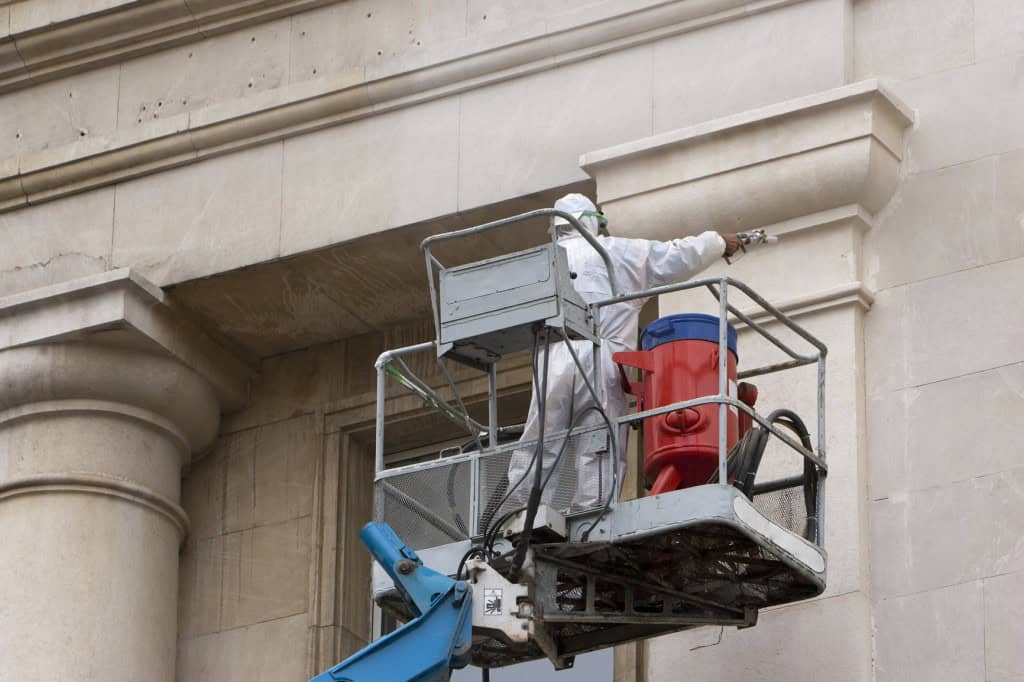As technologies have progressed over the years, so have the types of materials that are used for exterior facades in building construction. Traditional materials such as brick masonry, stone, concrete, and terra cotta are now being replaced or enhanced with architectural metal, glass, cast stone, aluminum, stainless steel, and exterior insulation and finish systems (EIFS).
Each of these materials has its own traits that are affected by the environment, which is why cleaning the exterior of structures is much more complicated nowadays rather than using the traditional pressure-washing or sandblasting techniques.
Factors to Consider
When undertaking a façade cleaning project, the following items should be taken into consideration:
- What is the purpose of cleaning the facade?
- What is the surface contaminant that you desire to remove?
- Has the surface been treated before?
- What adjacent materials will be subjected to the cleaning process?
- What safety or environmental impacts will be affected by the project?
- What are the desired results?
- What type of substrate is being cleaned?
The Purpose
The first step for the Owner and Contractor is to determine the purpose of the project. Common purposes for cleaning projects are below:
- Aesthetics: The most common is to remove dirt and contaminants, undesired coatings, and staining. However, a question to ask is what is the level of cleanliness that will be expected.
- Removal of Detrimental Materials: Cleaning or removal of algae, ivy, vapor impermeable coatings, carbon encrustation, or other detrimental materials that can cause damage to the substrate over time.
- Exposing Underlying Substrate Damage: Utilize cleaning methods to expose the substrate’s condition such as the removal of paints, coatings, or membranes to expose the substrate for further evaluation.
- Color Matching: When replacing mortar, patching concrete, repairing EIFS, replacing or patching masonry, the cleaning of the surfaces will be helpful when matching the replacement material to the parent substrate.
Test, Test, Test
Before tackling any cleaning project, the proposed method should be tested in an inconspicuous location. This should be reviewed prior to proceeding with the rest of the structure. A proper cleaning sample or mockup will help the Owner and Contractor reach a mutual expectation and understanding of the methods, processes, and achievable results.
Cleaning Methods
Determining the appropriate cleaning method starts with testing using the gentlest process first and then gradually increasing until the desired and proper results are achieved. Traditionally there are three types of masonry cleaning methods: water, abrasive, and chemical.
- Water Cleaning Methods: This is the gentlest and safest form of cleaning. Typical types of water cleaning methods are rinsing, light pressure water blasting, neutral impact cleaning (also known as the “water bar method”), steam cleaning, and hot water washing.
- Abrasive Cleaning Methods: This method is just as it sounds… abrasive. The use of various blast media to clean structures can be damaging to the substrate depending upon the pollutant being removed and the type of media being used. Traditional sand-blasting methods are quite aggressive, however, the use of slag, ice, baking soda, corn cobs, and others may be used successfully under controlled circumstances.
- Chemical Cleaning Methods: Chemical cleaning methods are the most common in restoration cleaning. Many manufacturers have proprietary formulations to deal with the multitude of circumstances that may be encountered. However, it is very important to understand the composition of the substrate prior to selecting a chemical detergent for cleaning. Certain chemicals react with mineral components in the substrate and can damage them irreversibly. Chemicals can also cause injury to persons, plants, trees, glass, and other surrounding materials.
Since some cleaning agents contain different forms and concentrations of acids, it is important to understand which substrates are acid-resistant and which materials are acid-soluble. Using acidic cleaners on acid-soluble materials can cause irreversible damage. Most calcareous materials such as limestone, marble, travertine, calcareous sandstones, and lime-based mortars can be damaged by acidic cleaners. Siliceous materials such as brick, terra cotta, granite, and ceramic tile are more acid-resistant. Prior to using harsh acidic cleaners or alkaline cleaners, gentler methods should first be employed. Lastly, take a look around at your surroundings and consider the proper protection required to prevent harm to adjacent materials, plants, rivers, and the public.
After considering the information provided above, the appropriate cleaning process can be selected to achieve a successful cleaning project.

